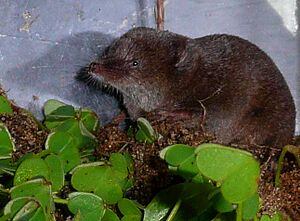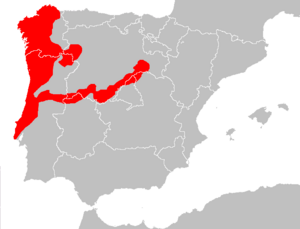Iberian shrew facts for kids
Quick facts for kids Iberian shrew |
|
|---|---|
 |
|
| Conservation status | |
| Scientific classification | |
| Genus: |
Sorex
|
| Species: |
granarius
|
 |
|
| Iberian shrew range | |
The Iberian shrew or Lagranja shrew (Sorex granarius) is a small mammal that belongs to the shrew family, Soricidae. You can find this tiny creature living in Portugal and Spain.
Contents
About the Iberian Shrew
The Iberian shrew is a medium-sized shrew compared to its relatives. It usually measures about 10.3 centimeters (about 4 inches) long, including its tail. An average adult weighs around 6.3 grams, which is less than a quarter of an ounce!
What Does It Look Like?
Adult Iberian shrews have a dark back that stands out against their lighter, tan-colored sides and off-white belly. Young shrews have a simpler look, with just two main colors: a darker back and a lighter belly.
Their fur is special because it helps them stay warm and dry in cold, damp places. Each guard hair has a small groove along its length. This groove helps to keep water from reaching their skin.
Unique Skull Features
Scientists can tell the Iberian shrew apart from other shrews in Europe by looking at its skull. The Iberian shrew has a small, flat snout. Its lower jaw (called the mandible) has a smaller bony part called the coronoid process and a narrow angular process. Also, a part of its skull called the temporal fossa looks like a triangle.
Shrew Family Tree
The Iberian shrew is part of a group of European shrews that includes the common shrew (Sorex araneus) and the crowned shrew (Sorex coronatus). All these shrews belong to the same order, Soricomorpha, and family, Soricidae.
It's tricky to tell these shrews apart just by looking at them because they look very similar. So, scientists mostly use their DNA to figure out how they are related. For a long time, it was hard to place the Iberian shrew correctly in the family tree, even with genetic tests. Some tests suggested it was closer to the common shrew, while others pointed to a closer link with the crowned shrew. Newer studies using more types of DNA now suggest it's more closely related to the crowned shrew.
Where and How They Live
Where Do They Live?
The Iberian shrew lives across the Central System mountain range in the Iberian Peninsula. Its home range stretches north into Galicia, Spain, and south to the Tagus (Tejo) River. Scientists also think that the Iberian shrew might live alongside the crowned shrew in the Iberian System.
What Is Their Habitat?
In the wild, these shrews like to live in forests and woody areas. They can be found in places with trees like juniper, beech, Pyrenean oak, Scots pine, evergreen oak, ash, or birch. They typically live at elevations between 500 and 2000 meters (about 1,600 to 6,500 feet) above sea level.
Who Are Their Predators?
Like many small mammals, Iberian shrews have predators. Some animals that hunt and eat them include domestic cats (Felis catus), European wild cats (Felis silvestris), and barn owls (Tyto alba).
Amazing Genetics
Special Chromosomes
Male shrews in the Sorex araneus group have a very unusual set of sex chromosomes, called XY1Y2. This means their Y chromosome is actually made of two parts: the original Y chromosome (Y1) and a piece that came from another chromosome (Y2).
The Iberian shrew is special even within this group. Most of its chromosomes are "acrocentric," meaning the centromere (the pinched-in part of the chromosome) is very close to one end. Other shrews in this group, like the common shrew, have mostly "metacentric" chromosomes, where the centromere is in the middle.
Super Long Telomeres
Another unique feature of the Iberian shrew is its telomeres. Telomeres are like protective caps at the ends of chromosomes, similar to the plastic tips on shoelaces. In most animals, these caps are quite short. For example, the common shrew has small telomeres.
However, the Iberian shrew has incredibly long telomeres, especially on the short arms of its acrocentric chromosomes. These telomeres can be about 300,000 base pairs long! This makes them the longest mammalian telomeres ever discovered. These "mega-telomeres" stay long thanks to an enzyme called telomerase and a process called homologous recombination. What's even more amazing is that the Iberian shrew is the only known Eutherian mammal (a group that includes most mammals, like humans) whose telomeres contain ribosomal DNA.


